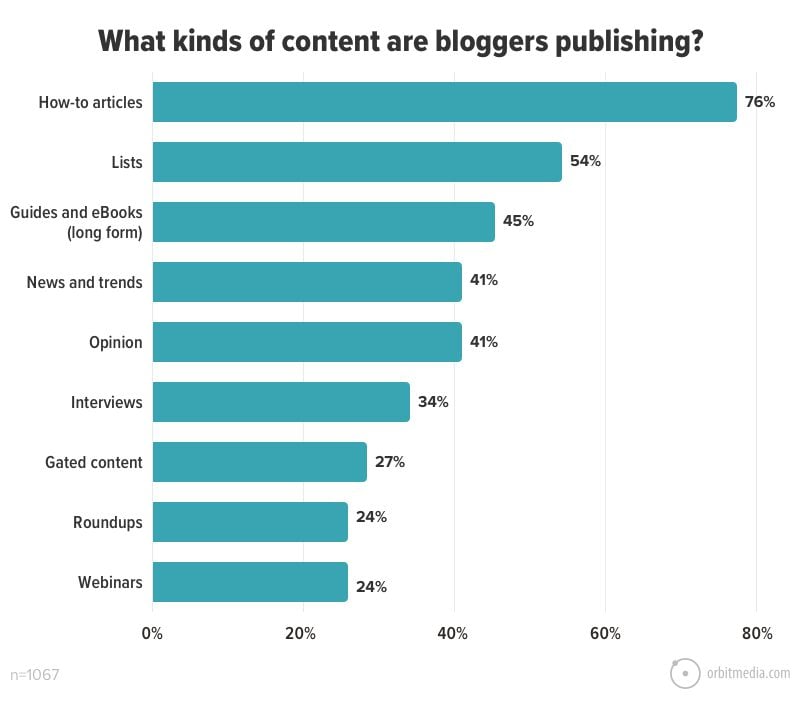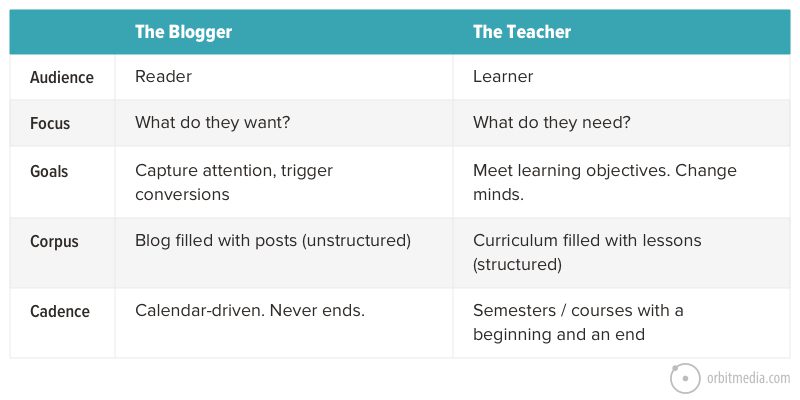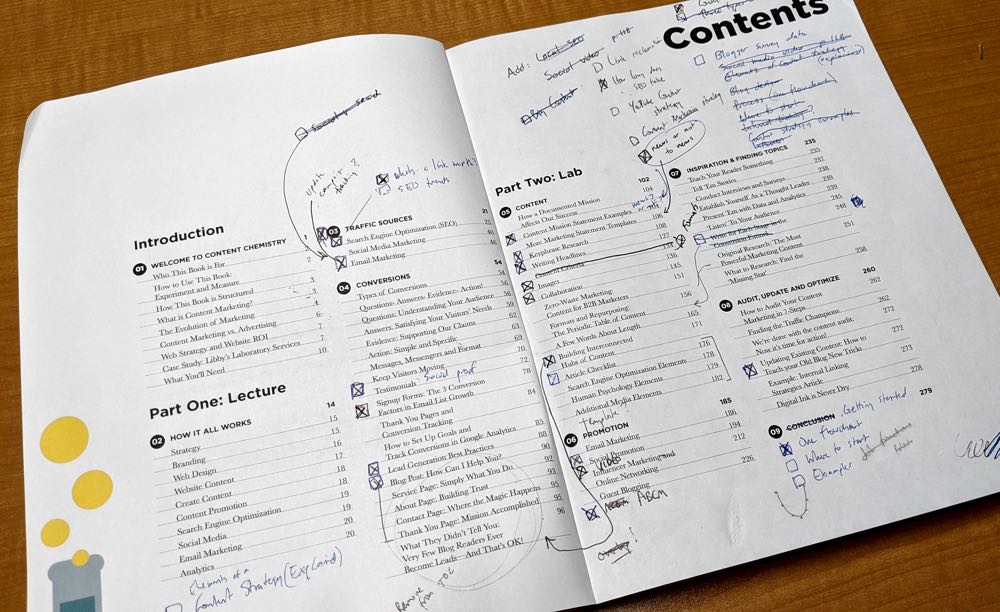“Content marketing is a test of generosity. The company or person who gives away the most helpful, useful information wins.”
We’ve said that 100 times in articles and presentations. And it’s true. Educational content is the foundation of most content marketing programs. How-to articles are the basis for most blogs.
Ask 1000 bloggers what they publish and most of them will tell you “how-to articles.”

It’s not the only content strategy. Some publish news and trends. Some focus on interviews and others publish thought leadership/opinion. But most content strategies, 76% according to our annual blogger survey, publish how-to articles.
And most of this content is published on blogs and on a schedule. This creates two problems.
Problem One: Blogs
Blogs were originally platforms for journaling. The word is a portmanteau from “web” and “log” and a log is basically a record of ongoing activity. So it’s all date-based.
Every new post goes on top of the posts that came before. They stack one on top of another. Maybe tagged with categories. Maybe with a search tool and filters. But mostly, it’s a big stack.
Problem: Blogs are reverse-chronological piles of articles.
But that doesn’t make for an ideal user experience. Even well designed blogs have UX problems. They don’t lend themselves to an organized structure. In fact, blogs are inherently disorganized.
A blog is a feed and it needs to be fed, which brings us to the second problem.
Problem Two: Content Calendars
Most content marketers aren’t worried about the fact that their work isn’t organized. We are worried about the calendar. We have goals to publish X articles per month. We have deadlines.
As I write this, I’m keenly aware that I’ve committed to a bi-weekly schedule and my Monday deadline is looming.
So the blog grows. Even if we diligently update old content, even if we add great internal links, it’s still an ever-growing pile. Click ‘publish’ and a new post becomes the top layer.
Problem: Marketing calendars push us to prioritize output over organization.
Content gaps go unnoticed. Older high-value articles are forgotten. Themes are overlooked. Connections missed. And it’s all because there is no pre-set point at which we step back and look at the corpus of our content.
So what’s the alternative?
The Fix: Curriculum Development
You’re already publishing how-to articles. So it isn’t a stretch to put these together into a unifying structure. It’s a small shift with a big impact… You are a teacher. Your content is the curriculum.
- The blogger thinks of the reader. What do they want?
- The teacher thinks of their learner. What do they need?
It’s another way to think about content development. Like marketing, the goal of the teacher is to change someone’s thinking. But the teacher comes from a different direction.

Here are 10 ways to shift your content strategy, away from an endless stream of how-to articles toward a more organized, complete body of work.
Strategy and planning
These first tips will lay the groundwork for the transformation.
1. Create an outline of everything there is to know on a key topics
It is an awesome intellectual challenge. The trick is to stay at a very high level and make the outline MECE, mutually exclusive (ME) and collectively exhaustive (CE).
2. Track your LBOW
That stands for “Lifetime Body of Work” and it’s the combination of everything you’ve ever published, every topic and format. When you see the list all in one place, you can compare it to your outline and then…
3. Start filling gaps
It’s likely that you immediately noticed gaps in your content and important topics you’ve never covered. Blog into those gaps. If your team isn’t qualified to publish on those topics, invite a guest to write for you. Or use a collaborative format (interviews, roundups) and include points of view from outside experts.
If a topic has been covered but the article is out-of-date, go back and update it, but don’t change the URL. That’s an SEO no-no.
Start small
These next actions don’t require big effort or radical change. You can do these right away.
4. Create a ‘Start Here’ page
This is an outline of the best content on your blog, organized into categories. Usually, it’s accessible from the blog landing page. Although we’re not promoting ours now, we had one for years. You can still see it here.
5. Remove the dates from your blog template
Probably, you’re publishing evergreen content, in which case, the date isn’t key information. Escape from date-and-deadline-driven thinking and focus on how the piece fits within the whole.
6. Add a ‘next’ button
Look at any article. What is the next piece they’ll need on their learning journey? Link to it.
Go big
Now we’ll get into big content, which are the 10x efforts with 100x results.
7. Combine similar articles into guides
The guide gets your reader off the blog pile and into a deeper, more structured piece.
8. Create an email course
Your “newsletter” was never really “news” anyway. Change the signup call to action to get a sequential series of emails, each with a lesson. Set it up as a welcome series in your ESP and have them sent out automatically on a regular schedule.
9. Create an online course
It is a big, but rewarding job. It will force you to reconsider and reorganize. Once complete, you’ll push the updated content back into articles. Quality and structure will improve immediately.
Do it for yourself or for a partner. We’ve created online courses for CXL (Content Strategy for B2B Lead Gen) and for Marketing Profs (SEO for Non-techie Marketers)
10. Publish a book
Another big, rewarding job that will push you into higher levels of quality and structure. For this, we’ll share a quick story…
Curriculum Example One: Content Chemistry
This is a true story, going back exactly 10 years ago today.
It was during my era of intense guest blogging. I had put myself ‘on tour’ and I was writing and pitching articles to all of my favorite blogs. Convince and Convert was on the list. I pitched a post.
The article was a recommendation for a more structured approach to blogging. The thesis was that with a bit of forethought, you could write articles that could be easily repurposed into a bigger format. Plan ahead and you can ‘blog into a book.’
The post was called Nice Blogs Finish Last and it went live 10 years ago, on June 5, 2012.
On that day I set out to follow my own advice and adapt content from our blog into a complete guide on the topic of content marketing. Here’s how:
- Created an outline (which would become the table of contents)
- Looked for gaps in the content
- Wrote posts that filled the gaps
- Wrote a book draft, adapting the more complete body of work
- Worked with an editor and designer
- Sent the PDF to a printer for a short run
I didn’t call it “curriculum development” but that is exactly what I was doing. And it really is a curriculum. Content Chemistry is a textbook used in at least a dozen colleges and universities.
As time went on, we updated our best articles and then updated the book. Some updates involve significant re-writes of entire sections. Here is a picture of the marked up table of contents for the 6th edition.

 |
Ann Handley Marketing Profs“Books are the holy grail of this educator mindset. Or are they? Sure — books are a way to plant a flag of authority around a topic (in our cases, content and content/writing). But you can also use the book(s) as a way to put forth ideas that you continue to improve on. That’s why you and I just finished writing new editions… a book doesn’t have to be the final of anything. It’s part of an ecosystem/body of knowledge. It’s allowed to change and evolve, too. Teachers are humble. The more you know and the more you learn, the more you realize how much you don’t know… and how much there is still to learn.” |
Curriculum Example Two: Copyhackers
This comes from Jo Wiebe, founder of Copyhackers and expert curriculum developer. She is the creator of one of the most popular copywriting courses on the web.
 |
Joanna Wiebe CopyhackersOur blog transformed from a bunch of posts to a content ecosystem – something far more structured and learner-focused – when Copyblogger’s Brian Clark said this to me: “Everything is content.” I was like, Oh yeah hmm it is. And suddenly every single thing I did, from answering support questions to presenting copy recommendations to a client, became content we could repurpose. That’s when we stopped focusing entirely on heavily researched long-form articles. Today, we organize short-form and long-form articles, video tutorials, presentation replays and live training sessions around categories we think of as channels for different audiences (like “the new freelancer channel”). And when one of our students fires us over a question about a gap in their learning, we repurpose our answer into multiple content forms in free and paid channels. For example, a student asked us how to coach clients on giving you feedback. So we answered that question live (recorded) and then scripted an entire 20-min free training session on exactly that, which we’ll be releasing soon and, of course, sharing across social media as snippets, etc. All with the plan of giving learners the foundation they need. And because we’re a training business, the idea is that, when that foundation is in place, the learner is in an outstanding position to join one of our programs. |
My takeaways:
- Let the learners tell you where the gaps are in your curriculum
- Go wide on formats but narrow on topics
Curriculum Example Three: Total Annarchy Newsletter
This from the one and only Ann Handley, Chief Content Officer of Marketing Profs and best selling author. We caught Ann just as she was wrapping up the second edition of Everybody Writes. (order it here)
She shared a super relevant excerpt from Chapter 25:
Good writing is good teaching.
It’s easy to embrace the teaching mindset when you’re writing a how-to. But it applies to everything we write: Slip on that teacher lanyard to not just explain but also to engage.
Think of your favorite teachers. You loved them in part because they loved the work. They wanted you to learn. They cared.
So yes: Show up with evidence, context, rigor.
But also! Bring your joy. Find the fun. Let your love for the job shine through.
Don’t just tell your readers that you feel something; tell them why you feel it.
Don’t just say what works; tell them why it works.
Share your thinking, your mindset, yourself.
“In other words, I think the ‘curriculum’ is the output. But the best ‘curriculum’ comes from the mindset of wanting to engage our ‘students.’ To not just teach but to get them excited, too.”
Ann makes a key point. Teaching is about the subject matter AND the motivation. The best teachers inspire the student to devour the material, then apply it with passion!
Another great example. Ann’s beloved fortnightly newsletter is a masterclass in storytelling. Let’s ask her about that…
“I try to teach the marketers on my list in a meta way how wrapping ideas in a more accessible, emotional, personal way is the key to engaging audiences. But to be honest, I get as much out of writing the newsletter as people get reading it. (Again — teachers show joy!) If writing that newsletter was joyless… if it felt for me like I was getting a root canal, readers would feel my pain. It would be zero fun to learn anything there.
More practically: I use the newsletter as feeder material for my speeches and books (also teaching opportunities!) I like to see what resonates… what parts capture people’s attention or imagination.
Nothing I do there is one-off…even though the mindset around newsletters that they are one and done: Mail once, never again is not true. The content is portable.”




